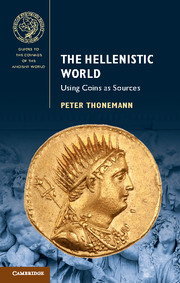Book contents
- Frontmatter
- Contents
- List of maps
- List of figures
- Preface
- List of abbreviations
- Maps
- Part I Globalization
- 1 Alexander and the transformation of Greek coinage
- 2 A ‘big’ Hellenistic world
- Part II Identity
- Part III Political economy
- Part IV Ideology
- Guide to further reading
- Appendices (by Andrew Meadows)
- Bibliography
- Index
1 - Alexander and the transformation of Greek coinage
from Part I - Globalization
Published online by Cambridge University Press: 05 December 2015
- Frontmatter
- Contents
- List of maps
- List of figures
- Preface
- List of abbreviations
- Maps
- Part I Globalization
- 1 Alexander and the transformation of Greek coinage
- 2 A ‘big’ Hellenistic world
- Part II Identity
- Part III Political economy
- Part IV Ideology
- Guide to further reading
- Appendices (by Andrew Meadows)
- Bibliography
- Index
Summary
The Sinanpaşa hoard
In the early years of the twentieth century, a poor Turkish farmer made his fortune overnight. Somewhere near the modern town of Sinanpaşa, deep in the highlands of central Turkey, the soil gave up an enormous hoard of ancient silver coins, buried there more than 2,200 years earlier (Fig. 1.1). We will never know how many coins the farmer originally dug up from his fields, since the coins were quickly dispersed on the international antiquities market. Still today, this remains the fate of most large coin hoards discovered outside of official excavations. As I write this paragraph, on 15 August 2013, a US coin-dealer called ‘zoderi’ is offering on eBay thirty-two tetradrachms of Alexander the Great, all evidently from a single hoard, for between $320 and $780.
Between 1919 and 1927, the American scholar and collector Edward T. Newell (1886–1941; Fig. 1.2) tracked down hundreds of coins from the Sinanpaşa hoard from coin-dealers in Athens, London and the United States. Thanks to Newell's efforts, we can today identify 670 coins which are known for certain to come from the Sinanpaşa hoard, almost all of them (640 out of 670) now in the collection of the American Numismatic Society in New York (IGCH 1395; Thompson 1983: 86–9).
From the surviving coins, we can be pretty sure that the hoard was buried in 317 or 316 BC. All of the Sinanpaşa coins are drachms on the so-called ‘Attic’ weight-standard (named after the abundant coinage of Classical Athens), weighing around 4.30 g. These drachms all carry the same images on their two faces. The front, or ‘obverse’ face, depicts a bust of Heracles, the legendary ancestor of the Macedonian royal house, wearing a lion-skin headdress. The back, or ‘reverse’, shows a male deity seated on a throne, holding an eagle on his right hand, with the name (in Greek) of a Macedonian king running vertically to the right of the throne. Most of the coins carry the name of the young conqueror who, between 334 and 323 BC, changed the course of world history: Alexander III (‘the Great’) of Macedon (Fig. 1.3).
The Sinanpaşa hoard bears silent witness to the dramatic events which had played out across the whole of the Near East, from the Mediterranean to India, in the twenty years or so before its burial.
- Type
- Chapter
- Information
- The Hellenistic WorldUsing Coins as Sources, pp. 3 - 23Publisher: Cambridge University PressPrint publication year: 2016



